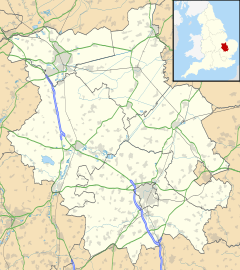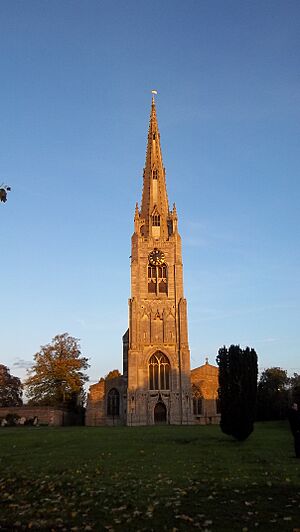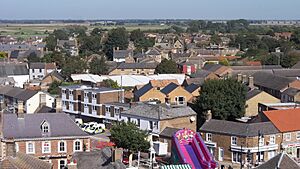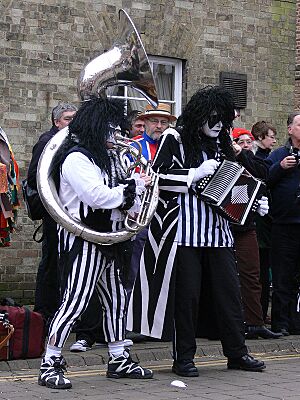Whittlesey facts for kids
Quick facts for kids Whittlesey |
|
|---|---|
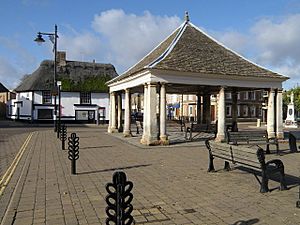 Market square |
|
| Population | 17,667 (2021 Census) |
| OS grid reference | TL271967 |
| Civil parish |
|
| District |
|
| Shire county | |
| Region | |
| Country | England |
| Sovereign state | United Kingdom |
| Post town | PETERBOROUGH |
| Postcode district | PE7 |
| Dialling code | 01733 |
| Police | Cambridgeshire |
| Fire | Cambridgeshire |
| Ambulance | East of England |
| EU Parliament | East of England |
Whittlesey, also known as Whittlesea, is a lively market town in Cambridgeshire, England. It's located about 6 miles (10 km) east of Peterborough. In 2021, around 17,667 people lived here.
Contents
The Name Whittlesey
The name Whittlesey has a long history! It comes from old words meaning "Wit(t)el's island". This name likely refers to a person named Wit(t)el and the fact that Whittlesey used to be like an island in a marshy area called a 'fen'.
You'll often see the name spelled 'Whittlesey' on maps and by the post office. However, the local train station uses the spelling 'Whittlesea'.
A Look Back in Time
Long ago, before the marshy fens were drained, Whittlesey was an island of dry land. People have lived in this area for a very long time. Digs nearby show settlements from as far back as 1000 BCE.
Bronze Age Discoveries
At a place called Must Farm, archaeologists found an amazing Bronze Age settlement. It's been called "Britain's Pompeii" because it's so well preserved. In 2016, experts found at least five homes that were 3,000 years old. They also found Britain's most complete prehistoric wooden wheel there! These finds show that Whittlesey was an important trade route around 1100–800 BCE.
Roman Times
The Romans built a road called the Fen Causeway in the 1st century CE. This road connected Whittlesey to Peterborough in the west and March in the east. Roman objects have been found nearby, including a Roman skeleton in the village of Eastrea.
Medieval Churches
The town's two main churches, St Mary's and St Andrew's, used to belong to large abbeys. This changed around 1540 when the Dissolution of the Monasteries happened. Even though Peterborough is close, Whittlesey is part of the Diocese of Ely.
Whittlesey Mere
Until 1851, there was a huge lake nearby called Whittlesey Mere. It was surrounded by marshland. A traveler in 1697 described it as "3-mile broad and six-mile long" with an island in the middle where many wild birds lived. She also said it could be dangerous because of sudden strong winds. Today, you can still reach the town by water through King's Dyke, which connects to the River Nene.
Brick Making and Old Walls
Whittlesey was once famous for its brickyards. The area of King's Dyke was a center for this industry for much of the 20th century. Only one brickworks remains today. The local clay was also used to make special walls called 'cob' walls. These unique walls were built when there was a tax on bricks. Some of these old, roofed clay walls can still be seen today.
A Thirsty Town
In the past, Whittlesey had many public houses (pubs). A local farmer once wrote in his diary in 1797, "They like drinking better than fighting in Whittlesea." Many of these old pubs are now private homes.
The Cholera Epidemic
In 1832, Whittlesey, then spelled Whittlesea, was hit hard by a serious illness called cholera. Many people became very sick. A diary entry from that time describes the suffering and loss.
Churches of Whittlesey
Whittlesey has two historic churches that are still used today.
St Mary's Church
St Mary's Church has parts that date back to the 15th century. It has one of the tallest spires in Cambridgeshire, reaching 171 feet (52 meters) high. The church also has a chapel that was fixed up in 1862 to honor Sir Harry Smith. St Mary's is a Grade I listed building, meaning it's a very important historic building.
St Andrew's Church
St Andrew's Church was first built in the 13th and 14th centuries. It was largely restored in 1872. The church has a tall tower with a clock. Its style mixes different Gothic designs from the 13th to 15th centuries. St Andrew's is listed as Grade II*, also a very important historic building.
The Market Place
The market is held in the Market Place every Friday. The town was first allowed to hold a weekly market in 1715.
In the middle of the Market Place is the Buttercross, which dates back to 1680. This structure was originally a place for people to sell goods. Later, it was used as a bus shelter, but now buses stop at a different location.
How Whittlesey is Run
Whittlesey has three levels of local government:
- Whittlesey Town Council: This is the local council for the town.
- Fenland District Council: This council covers the wider Fenland area.
- Cambridgeshire County Council: This council covers the whole county of Cambridgeshire.
These councils help manage public services and local matters. The town council is based at Peel House on Queen Street. The area of Whittlesey also includes the nearby villages of Coates, Eastrea, Pondersbridge and Turves.
Whittlesey is part of the North East Cambridgeshire area for national government elections.
A Brief History of Local Government
Historically, Whittlesey had two separate church areas, Whittlesey St Andrew and Whittlesey St Mary. Over time, these two areas started working together for local services. In 1849, they officially became one civil parish.
Later, in 1894, the area around the town became an "urban district" to provide more services. This urban district was expanded in 1926 to cover the whole parish. In 1974, the urban district was removed, and its functions went to the new Fenland District Council. In 1981, Whittlesey became a parish again, with its own Whittlesey Town Council.
Where is Whittlesey?
Whittlesey is located between Peterborough, which is 6 miles (10 km) to the west, and March, which is 11 miles (18 km) to the east. The River Nene is to the north, and Whittlesey Dyke is to the south. The modern A605 roughly follows the old Roman road, the Fen Causeway.
North of Whittlesey, there's a protected wetland area called a Ramsar site. There's also Morton's Leam, which is a special scientific area with many different plants and animals. To the south-east, you can find the Lattersey Nature Reserve.
Getting Around Whittlesey
Train Services
Whittlesea railway station (using the alternative spelling) is on the line between Ely and Peterborough. You can catch direct trains to places like Cambridge, Birmingham New Street, Liverpool Lime Street, and Stansted Airport.
Bus Services
Bus services connect Whittlesey with nearby towns such as Peterborough, Chatteris, March, Ramsey, and Yaxley.
Whittlesey also hosts the annual Fenland BusFest, a popular event where vintage buses and other vehicles gather.
Fun and Community in Whittlesey
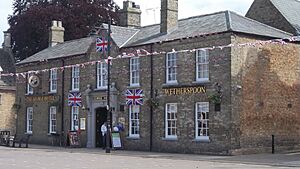
Whittlesey Festival
The Whittlesey Summer Festival takes over much of the town center each September. It features classic cars, food stalls, fairground rides, and even a steam engine. Students from Sir Harry Smith Community College also have an art competition during the festival. In 2009, local people raised £10,000 for bushfire victims in Whittlesea, Australia.
Local Businesses
For a while, there was a lot of competition between two big supermarket chains, Tesco and Sainsbury's, to build stores on Eastrea Road. This was even called "Supermarket Gate" in the news! In the end, a new Aldi store opened on Eastrea Road in June 2023.
Near the King's Dyke brickworks, you can see three large wind turbines. These 80-meter tall turbines are the biggest on-shore turbines in England and help power the McCains chips factory.
Whittlesey Museum
The Whittlesey Museum, located in the Old Town Hall, tells the story of the town's natural and cultural past.
The Whittlesea Straw Bear Festival
The Straw Bear festival is a unique tradition found only in a small part of Fenland. It's similar to other old customs in Europe where people dress up as animals.
Originally, on the day after the first Monday after Twelfth Night, a man or boy covered in straw would be led from house to house. He would dance for gifts of money, food, or beer. Farmers would even save their best straw for making the "bear" costume.
This custom stopped around 1909, possibly because the police saw it as begging. However, the Whittlesea Society brought it back in 1980! Now, it's a whole weekend event in January. On Saturday, the Straw Bear walks through the streets with its "keeper" and musicians. They are followed by traditional dance groups, including morris dancers and molly dancers, who perform along the way.
The festival also features traditional music in pubs, and a barn dance or ceilidh on Saturday night. On Sunday, the straw costume is ceremonially burned.
Media and News
You can get local news and TV programs from BBC East and ITV Anglia. Local radio stations include BBC Radio Cambridgeshire, Heart East, and Greatest Hits Radio East. There are also local newspapers like the Cambs Times and the Peterborough Telegraph.
Education in Whittlesey
Whittlesey has a secondary school called Sir Harry Smith Community College, which opened in 1953. There are also three primary schools: New Road Primary, Alderman Jacobs, and Park Lane Primary. Another primary school is in the nearby village of Coates.
Sports
The town has a non-league football club called Whittlesey Athletic. They play their games at Feldale Field.
Famous People from Whittlesey
- Sir Harry Smith (1788–1860): Born in Whittlesey, he became a very important military leader. He rose from a rifleman to a major general and was known for his role in the Battle of Aliwal in India. He also served as governor of the Cape of Good Hope.
- John Clare (1793–1864): A famous poet who mentioned "Whittlesea's reed-wooded mere" in his poem "The Shepherd's Calendar."
- L. P. Hartley (1895–1972): A novelist born in Whittlesey. His most famous books include The Go-Between.
- Edward Storey (1930–2018): A poet also born in Whittlesey. He wrote many books of poetry and a biography of John Clare.
- Gary Dighton (1968–2015): A national time-trial cyclist who competed in the 1992 Barcelona Olympics. He broke a national record and attended Sir Harry Smith Community College.
- David Proud (born 1983): A writer and the first disabled actor to have a regular role in the BBC soap opera EastEnders. He lived in Whittlesey and attended Sir Harry Smith Community College.
Images for kids
-
The Old Town Hall, now Whittlesey Museum
See also
 In Spanish: Whittlesey para niños
In Spanish: Whittlesey para niños


